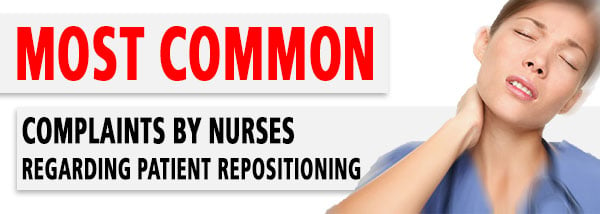Whether in a hospital or a nursing home, patient repositioning is a necessary yet difficult job for nurses. Not only are healthcare workers at risk for injuring themselves when performing these duties, they can also harm patients with improper moving techniques and devices.
Here are the most common complaints by nurses about patient repositioning:
- Overexertion injuries
The act of lifting patients or bending over for patient handling is often linked to overexertion injuries. According to the U.S. Bureau of Labor Statistics (BLS), overexertion and bodily reaction is the No. 1 cause of injury among hospital workers, accounting for almost half of these incidents. These injuries are typically musculoskeletal in nature, such as sprains and strains, with hurt healthcare workers having to take time off of the job. Nurses and nursing assistants made up the bulk of the 16,680 cases reported where workers missed work due to musculoskeletal injury from patient handling or related incidents.
- Risk of patient injury
The physical demand of the job of patient handling also puts patients at risk for falls and other injuries. In cases of manual lifting, lack of proper handling can lead to patient fractures, bruises and skin tears, the U.S. Occupational Safety and Health Administration (OSHA) notes. The rise of obesity in the general population as well as the increase in age of the overall healthcare workforce will likely also result in a higher risk of these injuries for nurses.
- Lack of patient handling tools and training
Hospitals and other healthcare environments are increasingly implementing patient handling tools and other resources to support appropriate patient repositioning. However, many nurses still do not have access to the instruments and training needed to reduce healthcare injuries and improve patient safety.
Challenges involved in patient handling include:
- Improperly trained workers or gaps in teamwork. In an example given by OSHA, some hospitals have safe patient handling programs that involve trained lift teams where two-person teams work together and use equipment specifically designed to lift and move workers.
- Long wait times for patient repositioning and transporting. Though healthcare workers may have access to equipment for patient handling, if these instruments are not in a convenient location, the wait times for patients who must be repositioned or moved to another location are lengthy.
- Use of traditional sheets vs. sliding sheets. Traditional sheets that are used in the moving and positioning of patients often produce friction that makes nurses’ jobs more difficult, causing them to overexert themselves and increase the risk of injury. Rather than traditional sheets, healthcare systems looking to boost their patient handling efforts could invest in sliding sheets that reduce the stress of lifting patients and getting them where they need to go quickly and easily.
To minimize the risk of overexertion injuries in healthcare workers and enhance patient safety, learn more about the Swift Ultraslide System by reusable healthcare textile manufacturer MIP.





.png)


